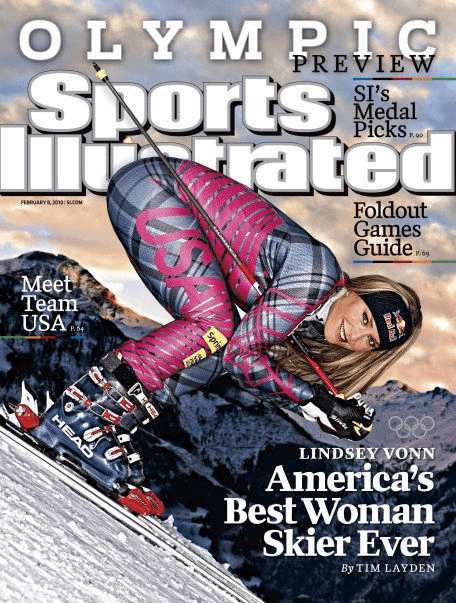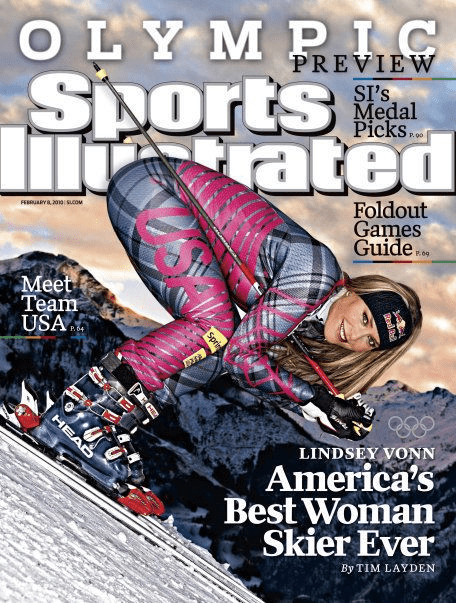

It is difficult to argue with the claim that female athletes receive less coverage than their male counterparts. In addition to considering how often female athletes are covered, journalists must also consider how they are portrayed when they are covered. Sports Illustrated, for example, is known for rarely portraying female athletes on its cover, but, on February 8th, 2010, Olympic skier Lyndsey Vonn was featured with the caption “America’s Best Woman Skier Ever.” Although this can be seen as a great moment for Vonn, and for female athletes in general, there were also those who took offense to the skier’s positioning in what some have called “a sexually provocative pose.”
The controversy surrounding the picture is two-fold. First, there is disagreement over whether the picture is or is not sexually suggestive. On the cover, Vonn is pictured on a mountain in a tuck position. As multiple commentators noted, male skier, A. J. Kitt, was featured on a 1992 Sports Illustrated cover in a similar pose. However, according to Nicole LaVoi, an expert on women in sports, the images of the two skiers differ in that Kitt is portrayed “in action,” looking forward down the hill, and wearing his helmet. Vonn, however, is clearly posed. She is obviously not moving down the hill. She is also facing the camera and is not wearing her helmet.
Those who find the picture to be offensive argue that it is just another of many examples of the journalistic tendency to portray female athletes as sex objects. Because women athletes receive less coverage, the instances where they are prominently featured are more significant. Portrayals that sexualize female athletes reinforce traditional gender norms and downplay female athletic ability. Photos like Vonn’s, they argue, may sell magazines, but they only work to increase interest in her body, not her athleticism.
Those who are not offended by the image either do not see any sexual connotations, or do not find the combination of sex and women’s sports to be problematic. Wendy Parker, a sports journalist, does not see anything provocative in the Sport Illustrated image, and she even points out that Vonn is fully clothed “from head to toe.” Then there are those who argue that it doesn’t matter even if it is a “sexy” picture. Sports Illustrated has a predominately male readership, so it may be a business-boosting ploy to promote reader interest in female competitive skiing. Additionally, female athletes have a right to celebrate their bodies without being told how to “behave.” As sports blogger Chris Chase asks, “Why can’t she be both the best skier in the world and really, really attractive too?”
Discussion Questions:
- Did Sports Illustrated do something ethically wrong in running the Vonn picture as they did? If they did, would it matter what their actual intentions behind running the photo were? If this cover actually increased interest in female competitive skiing, would that make an ethical difference?
- What reasons would you give to defend the decision to run the Vonn photo?
- Is the selection of cover photos, such as the Vonn shot, an important activity of sports journalists? Or are these purely business decisions? Are there more ethical issues than simply covering sports once sports journalists become part of a business such as Sports Illustrated?
- How would you have handled the selection of the Vonn photo for the cover if you ran Sports Illustrated? What values would guide your decisions?
Further Information:
Austin Knoblauch, “Lindsey Vonn’s Sports Illustrated cover shot skis into controversy.” Available at: http://latimesblogs.latimes.com/sports_blog/2010/02/lindsey-vonn-sex-sexual-pose-provocative-skier-olympics-winter-sexually-suggestive.html
Chris Chase, “Let the Lindsey Vonn Hype Begin: Vonn is Sports Illustrated Cover Girl.” Available at: http://sports.yahoo.com/olympics/blog/fourth_place_medal/post/Let-the-Lindsey-hype-begin-Vonn-is-Sports-Illus?urn=oly-217525
Mary Jo Kane, “Sex sells Sex, not Women’s Sports.” The Nation, August 15-22, 2011. Available at: http://www.thenation.com/article/162390/sex-sells-sex-not-womens-sports
Wendy Parker, “A Truly Warped Way of seeing Women Athletes,” Available at: http://www.wendyparker.org/2011/08/a-truly-warped-way-of-seeing-women-athletes/
Authors:
Danee Pye, Ph.D., & Scott R. Stroud, Ph.D.
Media Ethics Initiative
Center for Media Engagement
University of Texas at Austin
www.mediaethicsinitiative.org
This case study can be used in unmodified PDF form for classroom or educational settings. For use in publications such as textbooks, readers, and other works, please contact the Center for Media Engagement.
Ethics Case Study © 2018 by Center for Media Engagement is licensed under CC BY-NC-SA 4.0



